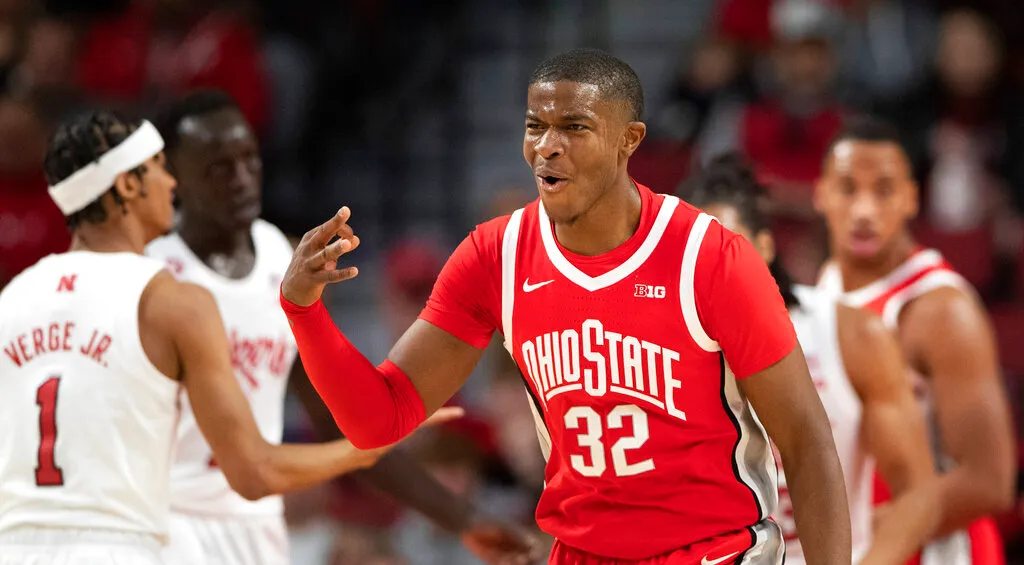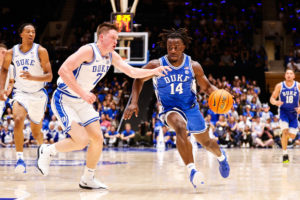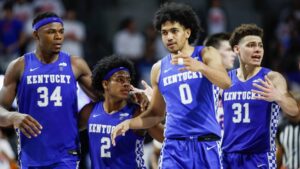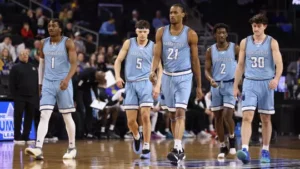
The Ohio State men’s basketball season in 2024–25 unfolded as a narrative of mounting frustration, sporadic brilliance, and tentative optimism. With a final record of 17 wins and 15 losses and a 9–11 finish in Big Ten play, the Buckeyes closed the year under the weight of unfulfilled potential. The mid-season coaching shakeup, declining defensive standards, fragile bench contributions, and recurring rebounding woes combined to sculpt a season defined as much by its shortcomings as by its spark-filled moments. Devoid of an NCAA tournament bid and mired in the middle of a storied program’s history, Ohio State’s campaign carried the ring of a decisive crossroads moment—one where self-reflection became a necessity, not a choice.
The season began under Chris Holtmann, whose recent years had seen the program slip from national relevance. Pressures mounted as expectations clashed with uneven performances on the court and growing concerns off it. The Buckeyes produced moments of true significance early on, most notably in a neutral-site victory over a traditional powerhouse that showcased the talent present on the roster. Those highs offered snapshots of what could be—electric scoring by the team’s star guard, efficient spacing, and flashes of defensive intensity that suggested an ability to contend. But within weeks of those promise-laden triumphs the cracks reappeared. The offense, while anchored by strong individual play, lacked cohesion; ball movement felt static at times, and offensive sets rarely empowered role players. The defense, once a program staple, wilted under pressure—open threes, unguarded cuts, chaotic rotations—these persisted as opposing teams probed weaknesses without consequence.
As December turned to January, the facade crumbled. On-court chemistry frayed as injuries accumulated and inconsistency set in. Bruce Thornton, a constant offensive threat, often carried the scoring load but it came at a cost. His hero-ball performances—30 points at a major arena in a dazzling showcase and 31 points in a winter showdown against a ranked conference rival—were undeniable highlights. Those games felt like proof that elite talent can conquer adversity. Yet they also underscored the flaw; the Buckeyes were too easily defined by Thornton’s efforts. Once he was contained or fatigued, the offense sputtered. Secondary scoring, a mix of energy roles and sporadic flashes from supporting cast, never became reliable enough to carry the team through hard stretches.
It was against this backdrop that the program opted for a mid-season coaching change. The removal of Holtmann and appointment of Jake Diebler offered a chance to reset. After a 6–2 run to end the regular season under new leadership, the team appeared to regain some spark. Ball handling improved, turnovers decreased, and defensive energy underlined impactful plays. Diebler’s system, while not revolutionary, introduced a newfound accountability that resonated with fans and players. The campaign’s elevated finish convinced the administration to grant him the role permanently, a decision carrying both hope and pressure into the offseason. For Buckeyes fans, the surge was encouraging — not because it erased earlier failures, but because it suggested that culture and effort, when reset, might reverse a troubling trend.
Beyond coaching, the season’s narrative was shaped by numbers—statistics that revealed as much as highlight reels. Offensively, the Buckeyes averaged nearly 79 points per game, shooting under 47 percent overall with about 37 percent from beyond the arc. These percentages, on the surface, reflect solid scoring ability. Yet the context matters: efficiency often existed in isolation, reserved for games where Thornton exploded or single opponents were overpowered. When defenses keyed in on him, supporting players struggled to find space or confidence. Turnovers remained moderate—around 11 per game—with a slight positive margin. That figure masks deeper issues: ball movement, measured in assists-to-field-goal attempts, lagged compared to peer teams in the conference. When possessions stalled, Ohio State fell into predictable sets, often leading to contested shots or turnover.
Rebounding revealed a more troubling story. Averaging slightly under 34 boards per game while yielding more to opponents, the team recorded a negative rebounding margin. It’s one thing to lose the occasional board, but consistently being outmuscled—especially on the defensive glass—created second-chance opportunities for opponents and limited transition chances for the Buckeyes. Compared to recent seasons, where Ohio State often won the boards by margins in the +2 to +4 range, this regression was stark. It was symptomatic of a broader dearth of physicality, particularly in the paint. Minnesota, Rutgers, and Wisconsin-style teams exposed this gap routinely, controlling the tempo via rebounding dominance and close-range scoring.
On defense, the cracks ran deep. Opponents regularly posted 73-plus points, a mark that should be surprising in the Big Ten, known for low-scoring contests. Ohio State’s defensive rating hovered past 107—placing it in the bottom echelon of the league. Why was this happening? A combination of factors: spacing in the modern game has pushed defenses to flatten and contest threes, and Ohio State simply lacked the personnel mobility to close out consistently. Their half-court rotations revealed slow footwork, often lagging guards and allowing driving lanes. In transition, players were slow getting back, enabling fast-break points and easy buckets. And rebounding again reared its head—defensive rebounds were frequently tip-taps to the opposition rather than secured possessions.
Moments of optimism threaded through the season’s tapestry. The early-season marquee win—an upset of a storied opponent in a high-profile venue—refocused attention on what the program could be. There were performances against top conference teams, road games where contributions went beyond Thornton. Guards stepped up; forwards showed flashes of physical presence; bench contributions became meaningful when they materialized. The season finale under Diebler, a spirited effort, carried more than just a record—it revealed a spirit that might underpin future success.
Still, systemic concerns overshadowed those highs. Ohio State lacks an imposing interior presence. Their frontcourt rotation—blessed with youthful tools and athleticism—never coalesced around a dominant scorer or rebounder. The portal additions and incoming freshmen, while promising, remain untested at this level. Guards remain the engine; centers and power forwards yet to emerge as pillars. Coaching in offseason must center on developing an interior identity—physical, aggressive, commanding. Without claims for dominance in the paint, perimeter offense and defense will remain undermined.
Culture and cohesion presented equally daunting questions. For fans posting on social forums, the ‘zero team offense’ label was more than snark—it pointed to a lack of overarching philosophy. With ball movement and off-ball motion inconsistent, the offense lacked predictability and flow. Leadership, too, was unclear. Thornton’s scoring and personality are undeniable, but converting that into team-wide voice and identity requires buy-in across the roster. Veteran leadership from multiple classes, taking ownership of locker room tone, would help anchor culture.
Defensive identity demands similar clarity. The team’s retreat from the defensive tenacity that once defined Holtmann’s earlier years signals deeper issues. Transition defense failed, help rotations were unreliable, and mental lapses proved costly. A fully committed defensive culture starts in practice, evolves through film sessions, and becomes part of recruiting pitch. Ohio State needs to recruit and develop players who value defense first—a common trait among elite collegiate programs.
Perhaps the season’s greatest indictment lies in the tournament result—a first-round Big Ten exit to a 15-seed. It encapsulated the campaign’s worst themes: lack of focus, over-reliance on individual stars, and systemic fragility. In single-elimination basketball, teams live or die by collective performance, not sporadic heroics. That the Buckeyes faltered so dramatically cast light not merely on one off-night but on a deeper issue: the inability to turn glimpses of brilliance into sustained excellence.
Nevertheless, the offseason offers a path forward. Diebler’s tenure promises continuity—something fans crave after abrupt transitions. His early results, though modest, suggest a team responsive to structure and accountability. Retaining Thornton, Devin Royal, Micah Parrish, and several rotation players preserves core continuity with which Diebler can build. Transfer portal additions aimed at physicality and defensive IQ, combined with freshmen development, could elevate performance. Yet these fall short without culture change and defined identity.
When pondering the road ahead, the central questions become clear: can Ohio State build a reliable interior presence in the paint? Can they instill a culture where defense is as celebrated as offense? Will they develop leaders who set the tone in practice, on the bus, and against adversity? Success in these areas would turn a middling season into a foundation for growth; failure could spiral into another campaign defined by promise undone.
Buckeyes fans have reason for both frustration and hope. The season’s worst days are behind them. But unless culture, defense, and interior strength are addressed, magic single wins won’t push them back into tournament relevance. For a program steeped in tradition and expectation, the 2024–25 season stands as a define-or-falter moment. With coaching continuity, recognized needs, and a spirited offseason, the team has everything it needs to redirect its course. But all the pieces demand commitment—not just effort, but belief in process. It’s true: Ohio State’s season ended in disappointment. But it also leaves intact the essential possibility of something greater ahead.





